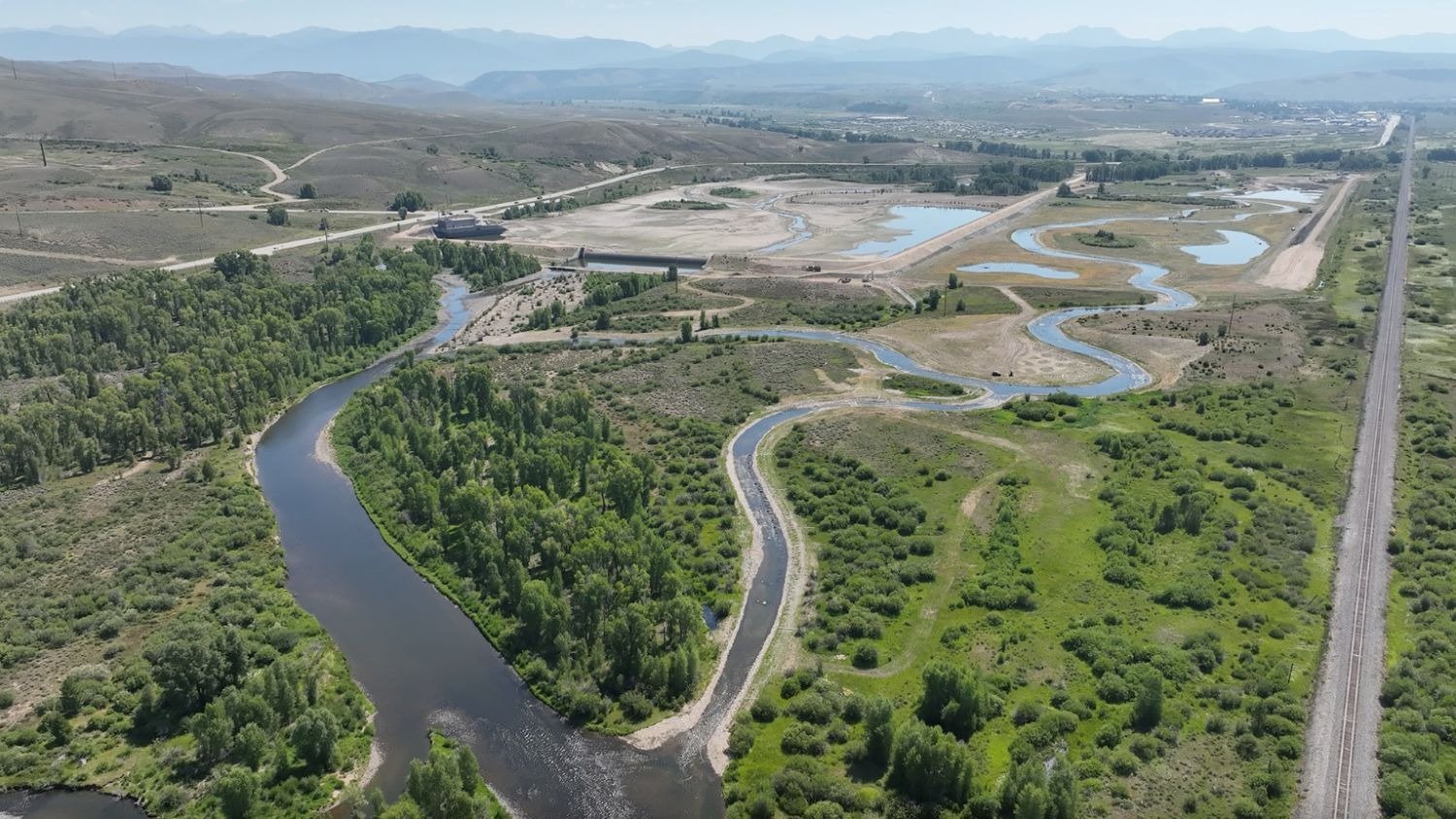Dry Gulch Reservoir litigation continues, briefs filed
As litigation surrounding the Dry Gulch Reservoir continues, two local water districts and Trout Unlimited (TU) have now filed response briefs with District Court, Water Division Seven, State of Colorado.
CTU VP Named to Gov's Forest Council
Neubecker Named to New Forest Council Aspen Times Staff Report
Grand County locals among proponents of instream flow laws
And TU member Kirk Klancke is right up front. http://www.skyhidailynews.com/article/20080207/NEWS/76165476
For Sale - Our Public Lands!
The BLM's Valentine's day sale - ok, lease sale - of 24, 835 acres of West Slope will earn us U.S. citizens a whopping 3.9 million bucks. Wonder how much that is in petrodollars? http://www.blm.gov/co/st/en/BLM_Information/newsroom/2008/blm_colorado_s_february.html
Arkansas River at Risk of Toxic Disaster
Officials are concerned that spring snowmelt may blow contaminated water out of a Leadville mine drainage tunnel and into the Arkansas headwaters. Read the Associated Press story. http://ap.google.com/article/ALeqM5jZu_kACT9XIYYzSCzey06LvOSSeAD8UQL4800
What Goes Down Must Come Up
Sooner or later, "recycled" water will be a fact of life for millions of Americans. For citizens of Orange County CA, the future has arrived. The CTU blog searched the globe to find this story in the Sydney (Australia) Herald. It's a very good article that explains how recycled water in Orange County will leave the ocean cleaner. http://www.smh.com.au/news/environment/getting-a-taste-for-recycled-ideas/2008/02/15/1202760599549.html
More briefs filed in reservoir litigation
http://www.pagosasun.com/frontpage.htm#Anchor-More-39590
By Chuck McGuire Staff Writer As part of ongoing litigation surrounding the proposed Dry Gulch Reservoir, two local water districts and Trout Unlimited (TU) have filed additional briefs with District Court, Water Division Seven, State of Colorado.In a majority decision issued in October, the Colorado Supreme Court ruled in favor of a TU appeal, which challenged water diversion and storage rights originally granted to the San Juan Water Conservancy District (SJWCD) and Pagosa Area Water and Sanitation District (PAWSD) by Judge Gregory G. Lyman in September 2006. Upon granting the conditional rights, Lyman paved the way for the districts’ development of Dry Gulch, a 35,000-acre-foot reservoir approximately two miles northeast of Pagosa Springs. Proponents of the project suggest it will meet area water needs to the year 2100.In its October ruling, the high court cited precedent established upon review of prior water court cases, including “City of Thornton v. Bijou Irrigation Co. (Colo. 1996).” Based on that case, the court wrote, “A governmental agency need not be certain of its future water needs; it may conditionally appropriate water to satisfy a projected normal increase in population within a reasonable planning period.“The governmental agency does not have carte blanche to appropriate water for speculative purposes. Accordingly, the governmental agency has the burden to demonstrate that its conditional appropriation is not speculative.”Citing another segment of Bijou, the court stated, “Only a reasonable planning period for the conditional appropriation is allowed. In Bijou, the water court’s findings of fact addressed what constitutes a reasonable water supply planning period, fifty years in that case, and found the existence of substantiated population and water use projections.”The Supreme Court added, “In accordance with the applicable statutory and case law requirements identified in this opinion, the water court should examine the evidence utilizing the elements applicable to determining whether the districts have met their burden for a non-speculative conditional appropriation, accompany its judgement with sufficient findings of fact based on the evidence, and fashion appropriate decree provisions, which may include ‘reality checks’ and volumetric limitation provisions for the districts’ conditional appropriation. The water court must also make factual findings concerning whether the districts can and will place the claimed amount of unappropriated water to beneficial use within a reasonable time.“Accordingly, we reverse the water court’s judgment, set aside the conditional decree, and remand this case for further proceedings consistent with this opinion. The water court, in its discretion, may take additional evidence and argument as it deems appropriate on remand.”Upon review of his and the Supreme Court’s findings, Judge Lyman ordered both sides to submit briefs “on remand.” Attorneys representing the opposing arguments did so on Monday.In its brief, TU urged the court (Lyman) “to make finds of fact on the Districts’ planning period, future population, per capita water usage, current water supplies and future demand for Dry Gulch system water.”Additionally, TU asked, if the court finds that there will be demand for Dry Gulch project water during the planning period, that it admit additional evidence regarding the water rights necessary to serve that demand. Further, TU suggested that even if the court accepted the districts’ demand projections, it could not decree the claimed water rights, because the amounts exceed what is reasonably necessary to meet the districts’ demand projections, and are not premised on actual water availability conditions.In its argument, TU expressed the following beliefs:• The court should determine the districts’ reasonable planning horizon at no later than the year 2040.• Districts’ population estimates by 2040 should be no greater than 34,291 people.• The districts will demand no water beyond their current supply to serve the population in the planning period.In their brief, the districts affirm a belief that the court has already heard adequate evidence to make the findings identified by the Supreme Court in its opinion, and to grant the conditional water rights requested. They do ask, however, that if the court believes additional evidence is necessary, that it schedule additional trial time to take such evidence.Meanwhile, the districts “have closely examined their projected water demands, and have chosen to reduce their conditional water rights claims in the interest of swiftly concluding the remand proceedings.”Following are the claims the districts are willing to reduce from their original application:• Diversion to storage from 200 cubic feet per second (cfs) to 100 cfs. • Initial fill from 29,000 acre-feet (ac-ft) to 23,000 ac-ft. • Annual storage limit from 64,000 ac-ft to 29,000 ac-ft. • Direct diversion from 80 cfs to 50 cfs. • Priority date from Mar. 14, 2000 to Dec. 20, 2004. • No reuse to extinction. • Add reality checks.The districts also suggest a 70-year planning period is appropriate under the facts and circumstances of this case. Further, they believe population projections are substantiated, based on normal rates of growth, and the amount of unappropriated water claimed is available and reasonably necessary to serve future water demands.The districts also contend that Dry Gulch will not adversely impact the San Juan River, “because once filled, only the actual annual water needs will be diverted, reserving the balance of total storage for periods when diversions are unavailable.” Additionally, they have proven under the “can and will” test that there is a substantial probability that the project can and will be completed with diligence, and the conditionally appropriated water will be put to beneficial use within a reasonable period of time.At their regular monthly meeting Tuesday, PAWSD officials couldn’t say how long Judge Lyman might take to review the briefs, or whether he would seek more evidence and set another trial date. PAWSD manager Carrie Weiss did, however, voice deep disappointment in the duration and mounting costs associated with the case, and expressed hope that the matter would be resolved soon.
Western & Colorado Water Project Staff Notes
February 2008 We gave two more presentations on the bog of Clean Water Act jurisdiction, and while it's clear that everyone thinks the system is a mess, we do not all agree on what the fixes are, which is one reason that the Clean Water Restoration Act is not moving in the House. The courts, meanwhile, have not been uniform in their rulings, but have ruled in a way that would harm the environment in only a very few cases (most recently in the 11th Circuit regarding Avondale Creek, but early on in one case in the 9th Circuit, which has otherwise done a pretty good job).
TU and the other parties to the Colorado water court proceedings to quantify the Black Canyon reserved water right are engaged in mediation. The court has stayed proceedings until April to allow negotiations to continue.
TU and others from the conservation community have helped to draft a bill that would that would more closely tie land use development (growth) to sustainable water supplies.
The water court judge in the Dry Gulch remand has ordered the parties to submit briefs outlining positions on how the case should be decided.
We have been preparing written testimony on Bear Creek, a semi-urban trout stream in the transition of the South Platte that is going to be removed from the 303(d) list. This stream is particularly prized by the local chapter of TU who have done extensive restoration work on the stream. Our testimony focuses on the need for continued vigilance on the part of the state, especially given that the improvements that have been observed in the fishery since the stream was originally listed have been short-lived.
We are evaluating available information on the Windy Gap Firming process in anticipation of the upcoming draft EIS.
We will be advocating for three bills to strengthen the instream flow program in the 2008 legislative session. The press release for the bills can be found at: http://www.cotrout.org/News/MediaRoom/TULegislativeAgenda/tabid/249/Default.aspx
We are working on sheepherding last year’s Instream Flow (ISF) proposals through the Colorado Water Conservation Board (CWCB) and preparing to bring 5 more streams forward in conjunction with the Colorado Department of Wildlife at the CWCB’s February ISF workshop.
Carbondale man named to new state forest panel
http://www.postindependent.com/article/20080213/VALLEYNEWS/98654861
Staff Report
Glenwood Springs, CO Colorado
February 13, 2008
 CARBONDALE — Colorado Gov. Bill Ritter named Ken Neubecker, a Carbondale resident and vice president of Colorado Trout Unlimited, to a newly created state group called the Colorado Forest Health Advisory Council.
CARBONDALE — Colorado Gov. Bill Ritter named Ken Neubecker, a Carbondale resident and vice president of Colorado Trout Unlimited, to a newly created state group called the Colorado Forest Health Advisory Council.
The multi-agency group will help “coordinate and lead efforts to address the mountain pine beetle epidemic” and other threats to forest lands in Colorado, according to a statement from the governor’s office.
“Colorado’s forests are vital to our environment, to our communities, to our economy and to our overall quality of life,” Ritter said in a prepared statement. “But our forests are at risk, and one of the biggest risks is the mountain pine beetle. This epidemic has decimated more than 1.5 million acres of mature lodge-pole pines over the past decade and could wipe them out in another three to five years.”
The council will develop a short-term action plan and will address many issues, including the implementation of priorities identified in community wildfire protection plans, methods to encourage establishment of forest improvement districts, and implementation of landscape-scale stewardship projects. The council will also establish long-term strategies for sustainable forest health that will address a “state-wide vision to protect communities from fire and restore forest health,” according to the governor’s statement.
The council will report back to the governor and the legislature annually. If recommendations require legislative action, those recommendations will be submitted by Oct. 1 prior to the January start of the legislative session, according to the statement.
Harris Sherman, executive director of the Colorado Department of Natural Resources, and Jeff Jahnke, state forester and director of the Colorado State Forest Service, will co-chair the council.







